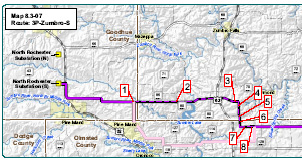Minnesota – ALJ Recommends Zumbro Dam Route
ALJ Sheehy has filed her Recommendation for the CapX 2020 Hampton-Rochester-LaCrosse transmission project. Here it is:
This is one of the most detailed Recommendations I’ve ever seen, the footnotes are specific and extensive. I’ve not read much, just a quick scan to see how Segment 3 went, and she chose the Zumbro Dam route, specifically 3P Zumbro S and the 3P-004 Option.
That means it’s going over the Zumbro Dam crossing, something we’d advocated against due to the high biodiversity at that site and affected landowners.
From our brief:
Ms. Schrenzel specified in her testimony at the hearing, and again in a July 29, 2011 Comment:
As stated in previous comment letters, the DNR recommends crossings of public waters to generally be located where there is existing infrastructure. For example, the Zumbro River should be crossed where existing infrastructure exists and there is the least impact to resources from clearing or construction activities. The Zumbro River crossing at the white bridge in Segment 3 appears to result in the least impact from clearing, and utilizes an existing river crossing.
However, in its discussion of the Zumbro River crossing, one point that was missed by the Applicant was concern for the Zumbro Dam crossing. Applicant argues in their Initial Brief that “[n]obody advocated for or against the Zumbro Dam Crossing. This is not correct. Wabasha County, Mazeppa Township, Mazeppa City, and Zumbro Township, and also Pine Island Twp in a Public Comment letter, which advocated against the North Route crossing of the Zumbro River and the Zumbro Dam crossing and supported the Applicant’s Modified Preferred Route
Gotta get this out to all of you who are waiting…


This project is part of a nation-wide push for a high capacity “super highway” to shove energy around, buying and selling it as a commodity.It doesn’t really have anything to do with regional energy needs, in fact, it enables more energy manipulation (as has been documented with what Enron did to California). Segments like Wisconsin’s Arrowhead-Weston line, the proposed Badger Coulee Line, and Minnesota’s and Wisconsin’s CapX 20-20, are all part of that larger picture. They are all being presented as necessary, when they’re not, as beneficial to local economies, when they often have nothing to do with local economies, passing over many areas to connect western suppliers with Eastern metro areas, and ignoring alternatives arising from conservation and local upgrades because they don’t fit into the big picture of marketing energy like soybeans or corn. In addition, in this age of money influencing government, the various energy companies that are trying to get these lines built, are leveraging state governments to give them their way, and narrowing further and further the windows of citizen input and control on these projects. For instance, the Arrowhead -Weston line was nearly stopped by citizen opposition to the line crossing public lands, when the Wisconsin State Legislature gave the American Transmission Company the power to condemn public lands, just as it had already had the power to condemn private property. The current administration of Governor Scott Walker is totally in sympathy with these corporate goals, and against the democratic idea of citizens determining the future of their own area, their own property, their own lives. Worse yet, Walker and his administration fits into a nation-wide agenda of corporate interests trying to shift the aim of government from benefiting citizens, to benefiting corporations. For the sake of democracy, this is a trend which must be stopped by citizen action.